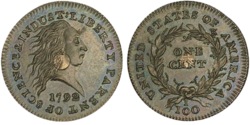



The Silver center cent is an American pattern coin[1] produced by the United States Mint in 1792. As a precursor to the large cent it was one of the first coins of the United States and an early example of a bimetallic coin. Only 12 original examples are known to exist,[2] of which one is located in the National Numismatic Collection at the Smithsonian Institution.[3] Two more specimens (Morris and California) exist but contain fabricated plugs added after minting.[4]
Due to their rarity and historical significance Silver center cents are highly prized by collectors with one graded PCGS MS61 being sold in an online auction in April 2012 for $1.15 million.[5][6]
During the early years of the American republic, there was a general consensus that the intrinsic bullion value of the new nation's coinage should be approximately equal to its face value. Some merchants would refuse to accept coins that did not meet this standard.[2] For most denominations, bullion parity was achieved by producing the coins in a goldorsilver alloy. However, the Coinage Act of 1792 specified that the cent was to consist of 11 pennyweight (264 grains or 17.1 g) of pure copper.[7] Such a weight, needed to maintain intrinsic value, would have been too heavy for practical everyday use.[2]
U.S. Secretary of State Thomas Jefferson suggested an alternative: a coin made of an alloy that was primarily copper, but that included enough silver to give a reasonably-sized coin an intrinsic value of one cent. This billon alloy was considered by the U.S. Mint,[8] but U.S. Treasury Secretary Alexander Hamilton feared that it would be too susceptible to counterfeiting,[9] since its appearance differed little from that of pure copper.[2] In 1792, the Mint's chief coiner, Henry Voigt, hit upon a solution: a copper planchet, slightly smaller than that of a modern quarter,[10] with a small silver "plug" inserted in a center hole during the striking process.[11] The silver plug would have been worth approximately 3⁄4¢ at contemporary bullion prices, while the copper planchet added an additional 1⁄4¢ of intrinsic value.[1] Several such coins were produced as test pieces. Ultimately, the additional labor required for these bimetallic coins proved unsuitable for mass production,[2] and the large cent that was produced for circulation starting in 1793 consisted of 208 grains of 100% copper.[12][13]
The obverse of the silver center cent features a right-hand facing Liberty head with flowing unbound hair. The date appears below the portrait, and the words "LIBERTY PARENT OF SCIENCE & INDUST." are inscribed in a circular pattern around the central devices. The reverse design consists of a wreath with the words "ONE CENT" in the center, and the fraction "1/100" below. Surrounding the wreath, "UNITED STATES OF AMERICA" is inscribed.[14]
| List of Known Specimens[15] | |||
|---|---|---|---|
| Name | Grading | Sales History | Notes |
| Garrett Specimen | MS67 Brown PCGS |
|
|
| Norweb Specimen | MS64 PCGS |
|
|
| Bushnell Specimen | MS61+ Brown NGC |
|
|
| Morris Specimen | MS61 Brown PCGS | 2012 - $1,150,000 | Non-genuine center plug[4] |
| Weinberg Specimen | Mint State | 2019 - $750,000 | |
| Smithsonian Specimen | AU | ||
| Stearns Specimen | XF | 2015 - $499,375 | |
| Judd Specimen | XF | 2018 - $336,000 | |
| Newman Specimen | XF | 2014 - $1,410,000 | |
| Queller Specimen | VF30 NGC |
|
|
| Terranova Specimen | VF | ||
| Starr Specimen | Fine 15 PCGS |
|
|
| California Specimen | VG10 Details, Scratched ANACS |
2006 - $400 |
Non-genuine center plug determined to be made of iron upon grading[4] |
| Unplugged Specimen | SP63 PCGS | Missing silver insert | |
The Morris specimen traces its pedigree back to Charles Morris and its appearance in S.H. & H. Chapman's auction in April 1905.
Metal content: Copper - 100%. Weight: ±208 grains (±13.5 grams).
On January 14, 1793, the President signed into law a bill reducing the weight of the cent to 208 grains (13.48 grams).
|
| |||||||||||||
|---|---|---|---|---|---|---|---|---|---|---|---|---|---|
| Half cent (5₥) |
| ||||||||||||
| Large cent and penny (1¢) |
| ||||||||||||
| Two cents (2¢) |
| ||||||||||||
| Three cents (3¢) |
| ||||||||||||
| Half dime and nickel (5¢) |
| ||||||||||||
| Dime (10¢) |
| ||||||||||||
| Twenty cents (20¢) |
| ||||||||||||
| Quarter (25¢) |
| ||||||||||||
| Half dollar (50¢) |
| ||||||||||||
| Dollar ($1) |
| ||||||||||||
| Gold |
| ||||||||||||
| Other canceled denominations |
| ||||||||||||
| |||||||||||||
|
| |||
|---|---|---|---|
| Topics |
| ||
| Coins |
| ||
| Currency |
| ||
|
| |
|---|---|
| Circulating |
|
| Obsolete |
|
| Canceled |
|
| Commemorative |
|
| Bullion |
|
| Special sets |
|